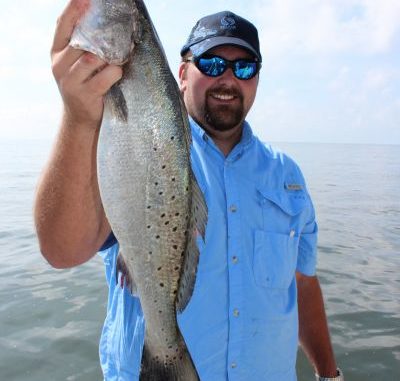
LDWF, Apache Corporation working to save trout-fishing hotspot.
It appears that Ship Shoal 26 — better known as “the Pickets” and serving as a trout-fishing Mecca — will continue to be a fishing hotspot for the time being. But for how long remains the question. The structures in the block located out of Dularge and Cocodrie were slated for removal in compliance with the federal Idle Iron Policy, which requires rig owners to remove their structures after a five-year period of inactivity.
The lease for Ship Shoal 26 terminated in November 2012, and Apache Corporation had begun removing wellheads and pilings in the oil field block.
But at the 11th hour of the rig’s existence, Apache and the Louisiana Department of Wildlife and Fisheries have come to an agreement that will at least temporarily delay the removal of the fish-attracting structures.
The LDWF announced on Friday that, at its recommendation, Apache has agreed to put off the decommissioning of the facilities. The company also will pay for a water-bottom survey to determine the extent of rock and shell-pad bottoms surrounding the rig.
That’s welcome news to anglers such as Capt. Bill Lake of Bayou Guide Service. Lake has fished the Pickets area for more than 40 years and said the place is a well-known hotspot for both speckled trout and redfish.
“I talked to the foreman on the barge out here, and he said they were going to leave (the rig) up for a year while they decide what to do with it,” Lake said.
While the press release sent out by the LDWF is non-committal on a time frame, it does detail a chain of events that appears to support the strengthening of the shell bed below the surface.
First, a “six- to eight-week survey will assess the status of the existing bottom structure since the platform was installed in the late 1960s and early 1970s, before precise installation records were available,” the release states. “The (LDWF) and the U.S. Bureau of Safety and Environmental Enforcement will then determine the best course of action, which may involve augmenting the site with concrete and additional materials to enhance fish production and provide habitat. If this strategy is implemented, the remnant of the platform or its enhanced shell pad will then be marked by buoys.”
Whatever path is followed, Ship Shoal 26’s shell bed seems to be a priority. And for good reason, the LDWF release states.
“When an oil field structure is removed from an area, but the associated rock pad around the base remains or is enhanced with additional appropriate material, the area will continue to provide habitat for surrounding species,” the release reads. “Speckled trout and redfish are typically associated with low- to mid-relief structures which provide a refuge from currents, where they can remain in an area without expending energy while preying on food as it is carried across the structure.”
Lake said anything the state and Apache can do is important, but if had his way, he’d leave the rig up and also enhance the shell bed beneath it.
“We’re only in about 12 feet of water here, so they can’t topple it and sink it because the water is too shallow,” the veteran guide said. “I’m hearing they’ll likely pull it and enhance the shell bed. That’s good, but it’s not the best thing.
“I’ve fished artificial reefs before, and what I find is that they’re fine for a few years. But when you get hurricanes and (sedimentation,) they tend to get covered up and become part of the natural water bottom.”
But John Walther, the Coastal Conservation Association of Louisiana’s habitat chairman, said it’s not that easy. CCA-Louisiana has expressed interest in working on the Ship Shoal 26 shell bottom, and has worked on similar reef projects in the past.
“There are two parts to this,” Walther said. “First, the company is under mandate with Idle Iron to take (the rig) down. Apache is facing that. It appears they will apply for an extension which will allow for a study and allow for all of us to plan so we can get something done on the site. Second is that the artificial reef program is for underwater structures. The bottom habitat and what it supports is what I’m worried about.
“We’ll get out there and mark it with mooring buoys like we’re about to do with the Buras (High School) Reef (at California Point,) and like we did at Calcasieu Lake. That gives it a visual identity and a place to tie up. The buoys have a cleat on the framework that allows that.”
Walther said decommissioned wellheads and rigs are being removed from local waters at a quickening pace. He noted that during a recent trip to Bay Marchand, he saw rigs coming down and that CCA had no forewarning that was coming.
“We have to move forward on this before we lose (Ship Shoal 26) like we lost hundreds of others before we even knew about them,” he said. “So I’m very grateful to Apache for working with us on this. I hope other companies work with us and give us a chance to preserve this critical underwater habitat.”
An interesting twist comes in the form of legislation that was proposed on Capitol Hill late last month by U.S. Senator David Vitter. The bill would make it easier for rig owners to leave such structures in the marine environment and serve as artificial reefs.
Whether the proposed legislation would have an effect on Ship Shoal 26 is not yet known.